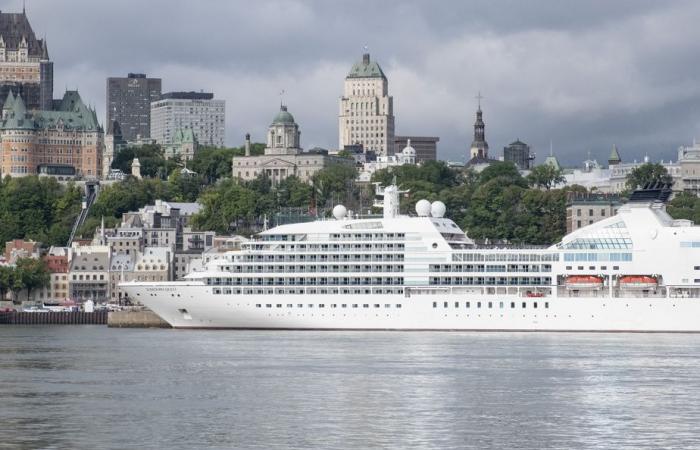(Quebec) A first important step has been taken towards the installation of huge electric charging stations in the port of Quebec to allow moored cruise ships to turn off their oil generators, which have been bothering citizens of Old Town for years -Quebec.
Posted at 1:32 p.m.
Ottawa announced Friday a grant of $22.5 million to electrify the three wharves serving cruise ships as well as a section of the industrial wharves reserved for freight ships.
These terminals, which will come into service in 2027 if all goes well, will allow the huge ships moored at the Port of Quebec to cut off their generators. Studies have shown that a 50,000-ton cruise ship – or less than 1,000 passengers – emits as many fine particles as 50,000 cars traveling at 130 km/h.
By way of comparison, the largest ship to pass through the Port of Quebec this year, the Norwegian Joyhad a capacity of 3700 passengers.
The capital is particularly popular with cruise passengers. The Port of Quebec planned to welcome 118 cruise ships in 2024, which remain moored at the quay for several hours while their engines are running.
“This is excellent news,” reacted the former municipal councilor of the Cap-aux-Diamants district Jean Rousseau, contacted by The Press. “I live in Place Royale and when I open my windows, we experience the soot, the dirt, the odors… The fumes from the ships. There is very heavy pollution when these ships are present and we have been calling for action in this direction for years. »
The federal Minister of Public Services and Procurement, Jean-Yves Duclos, was all smiles during the announcement Friday morning. The Quebec MP has been talking to citizens about the nuisance caused by boats for years.
“We are investing in the quality of life and the health of people who have the chance and sometimes also the challenge of living in central neighborhoods close to the Port of Quebec,” he said. We think of the Old Port, of Petit-Champlain, people who are proud to live here, but who will benefit from a cleaner environment. »
The 55 million project can count on 22.5 million from the federal government. The Port of Quebec will extend 11 million and hopes that Quebec will contribute 21.5 million.
“We are very confident that the Quebec government will move forward, with the signals it has already sent,” said Mr. Duclos. Because it’s good for the Quebec region. We know that there are challenges to having a port in downtown Quebec, there are also solutions. »
The Press contacted the office of the Minister of Transport on Friday to find out if Quebec would move forward. We had not received a response at the time of publishing these lines.
Some 15 MW per boat
Currently, 40% of cruise ships on the planet are equipped with the technology necessary for an electrical connection. During the COVID-19 pandemic, several cruise lines took advantage of the forced docking of boats to adapt them to electric power, explained the president and CEO of the Port of Quebec, Mario Girard.
“All the boats currently under construction will be equipped for electrification,” adds Mr. Girard, who has also just been appointed general delegate of Quebec in Tokyo, and will leave the management of the Port in February.
According to the CEO, only 3% of ports have electrical terminals. But the electrification of platforms is a major and inevitable trend, according to him.
Mario Girard must now convince Hydro-Québec and the Ministry of the Economy, Innovation and Energy to grant the Port an industrial rate. “It takes a lot of megawatts. It’s a huge thing to hook up on a cruise ship. We don’t plug in an extension cord like we have at home! “, he blurted.
According to him, each boat at the dock would require 15 megawatts, or power capable of supplying 2,400 homes with electricity. “It’s many, many, many houses. It’s huge. This is a special project for Hydro-Québec. But we are confident because it is not the season with the highest demand, in September, October or November. It makes sense for Hydro-Québec. »
Nearly 8 million at the Port of Montreal
Ottawa is also announcing two investments at the Port of Montreal for the electrification of freight docks. Some $3 million will go toward electrification at the Viterra terminal, which receives CSL ships from the Great Lakes during the grain season. At the Bickerdike terminal, 4.5 million will be injected by the federal government to electrify the wharf which accommodates Oceanex ships shuttling between Montreal and Saint John, Newfoundland.






